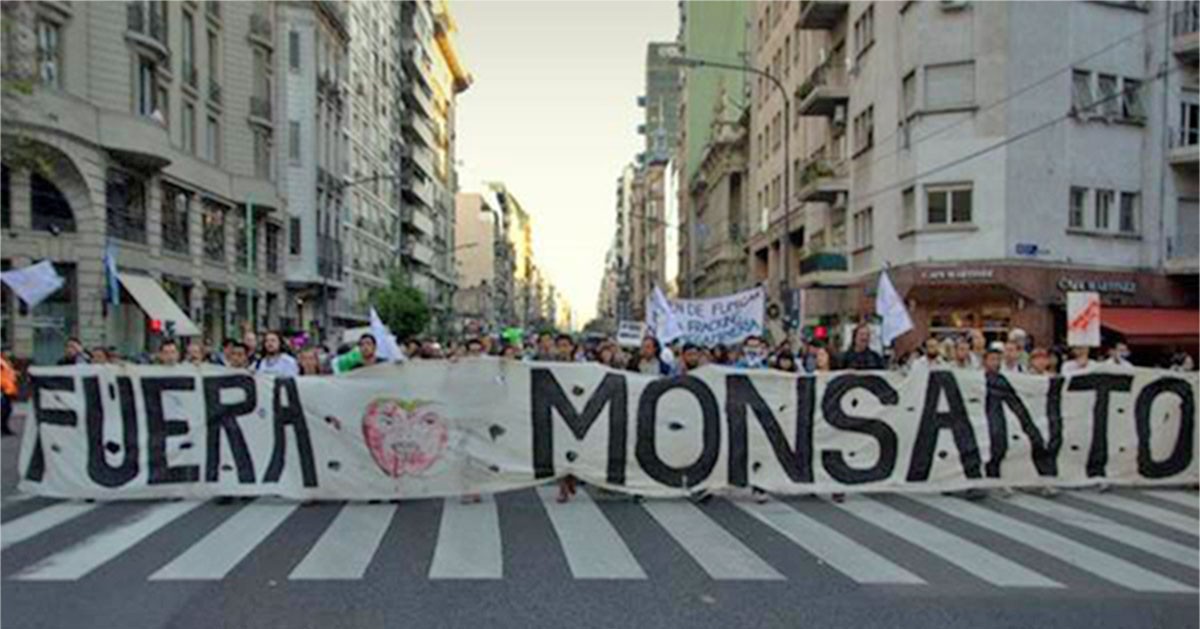Please support protesters in Argentina against the GMO onslaught 
Argentina’s rural communities are being devastated by the GMO/toxic model of agriculture, writes Jonathan Matthews
On 11 November demonstrators will take to the streets in Argentina to protest against Monsanto-Bayer and its silent genocide – the terrible chemical onslaught Argentina has suffered since vast areas of its arable land (currently running at a massive 80 per cent) were turned into GMO soy monocultures, with significant quantities of GMO corn and cotton being grown as well. They’re also protesting against an entirely new threat – the 50,000+ hectares of GMO wheat that have recently been planted despite the HB4 glufosinate-tolerant crop not being fully approved for commercialization in Argentina and GMO wheat not having approval anywhere else in the world. This typifies Argentina’s role as a global proving ground for GMOs. Argentina has also been used by the agrochemical industry as its bridgehead to the rest of Latin America, including for smuggling its products into countries in which they’re banned. Call for help The protesters are asking if you can add your voice to those saying NO to GMOs in Argentina by helping to support the protest financially, as mass mobilising requires spending on banners, a sound system, posters, and advertising on social networks. You can do that directly via PayPal or via the normal GMWatch donation page. But if you donate via GMWatch, please make sure you tell us via email ([email protected]) that it’s for the protesters and the amount you wish us to transfer. Democratic deficit The main anti-GMO protest will take place outside the seat of the Argentine parliament, the National Congress building, in the capital, Buenos Aires, at 1700hrs (UTC-3) on 11 November. There couldn’t be a more appropriate place for a protest because the demonstrators are up against a powerful political consensus in support of soy among Argentina’s elite. That’s because the country’s position as the world’s third largest exporter of GMO soy not only generates huge profits for agribusiness interests and hence substantial tax revenues, but constitutes Argentina’s main source of foreign income. As a result, Argentina’s governing and business classes have been extremely keen to downplay a host of health, environmental and human rights problems. Razing the forests, attacking the Indigenous This democratic deficit means a dire lack of representation for those at the sharp end of Argentina’s GMO revolution. That includes the Indigenous peoples who live in Argentina’s native forest areas, like the Gran Chaco, and depend on their biodiversity. Since 1996, when the government first authorised GMO soy, about a quarter of Argentina’s forests have been cleared for soy production. The razing of their forest homes has been accompanied by harassment and even violent attacks on the Indigenous by the soy producers expanding into their territory. Small farmers have also been driven off their land in favour of mechanised production by giant conglomerates. Increasing poverty and malnutrition Growing hunger and malnutrition have also been caused by Argentina’s GMO revolution, with the number of people lacking access to a “Basic Nutrition Basket” (the government’s measure of poverty) exploding as food crops that were grown to feed local people have been replaced by vast monocultures of GMO soy grown for export as animal feed for intensive farming operations in places like Europe and China.  Raining poison on communities Raining poison on communities
The other people hugely affected by Argentina’s GMO revolution are the farmworkers and rural residents directly exposed to the massive use of pesticides, particularly glyphosate. However, with the growth of glyphosate-resistant weeds, large quantities of highly toxic herbicides, such as 2,4-D and paraquat, have been added to the mix. Around 12 million Argentines live in soybean growing areas, often in villages surrounded by GMO soybean fields. They have become known as “pueblos fumigados” – the sprayed villages or small towns. More than 500 million litres of pesticides are thought to be sprayed annually in the vicinity of such communities and they have suffered startling increases in birth defects, infertility, stillbirths, miscarriages, chronic respiratory illnesses, and cancers. The contamination also moves through the water and food supply to affect those beyond the areas directly sprayed. A recent graphic illustration of the kind of nightmare rural communities in Argentina are facing came at the end of last month when more than 700 people in the Chaco ended up going to hospital because the two communities they belonged to had been poisoned during repeated aerial spraying of pesticides thought to include glyphosate, 2,4-D and paraquat. Their home gardens, small farms and orchards were also hit, as were their water sources. This outrage gained little initial attention because many of those harmed in this remote location were Qom – a long-persecuted Indigenous community – and/or poor, while the agribusiness responsible is owned by a politically well-connected family. Beacons of resistance Encouragingly, the sprayed communities have increasingly become beacons of resistance, and have attracted the support of doctors, lawyers and researchers, appalled by the suffering among those living and working in the vicinity of GMO plantations. There have been campaigns to try and keep spraying away from inhabited areas and particularly rural schools, and to ban aerial fumigation. There are also demands for a transformation towards agroecological production. The organisers of the 11 November protest describe it as a march against Bayer/Monsanto and the GMO/toxic model of agriculture. The kind of slogans that will ring out around the National Congress will include: - Fuera Monsanto-Bayer! – Monsanto-Bayer out!
- No a los transgenicos! – No to GMOs!
- Paren de fumigar! – Stop the fumigation!
- Paren de fumigar las escuelas! – Stop spraying the schools!
- Agroecología ya! – Agroecology now!
Please join us in amplifying their voices. |